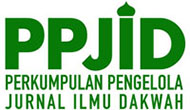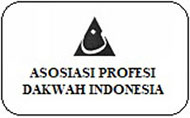Virtual Sufi Da'wah in Preserving Religious Harmony in North Sumatra
Abstract
Keywords
Full Text:
PDFReferences
Al-Rawi, A. (2016). Facebook As a Virtual Mosque: The Online Protest Against Innocence of Muslims Facebook As a Virtual Mosque: The Online Protest Against Innocence of Muslims. Culture and Religion, 17(1), 19–34. https://doi.org/10.1080/14755610.2016.1159591
Anwar, A. (2011). Sistem Komunikasi Indonesia. Bandung: Simbiosa Rekatama.
Arabi, K. S. M. (2017). Dawah Dengan Cerdas; Bekal-Bekal Untuk Aktivis Dakwah. Yogyakarta: Laksana.
Aziz, M. A. (2017). Ilmu Dakwah (Edisi 6th). Jakarta: Prenada Media Group.
Azra, A. (2016). Transformasi Politik Islam; Radikalisme, Khilafatisme dan Demokrasi (Edisi 1th). Jakarta: Prenada Media Group.
Beckford, J. A. (2013). Religious Diversity in Prisons: Chaplaincy and Contention. Studies in Religion/Sciences Religieuses, 42(2), 190–205. https://doi.org/10.1177/0008429813479293
Bélanger, J. J., Hameiri, B., Wibisono, S., Louis, W. R., & Jetten, J. (2019). A Multidimensional Analysis of Religious Extremism. Frontiers in Psychology | Www.Frontiersin.Org, 1. https://doi.org/10.3389/fpsyg.2019.02560
Brubaker, P. J., & Haigh, M. M. (2017). The Religious Facebook Experience: Uses and Gratifications of Faith-Based Content. Social Media and Society, 3(2). https://doi.org/10.1177/2056305117703723
Bruinessen, M. van. (2009). Islam and Modernity: Key Issues and Debates (M. K. Masud & A. Salvatore, eds.). Edinburgh University Press.
Casanova, J. (2019). Public Religions in the Modern World. In Public Religions in the Modern World. Chicago: University Of Chicago Press. https://doi.org/10.7208/chicago/9780226190204.001.0001
Cheong, P. H. (2016). The Vitality of New Media and Religion: Communicative Perspectives, Practices, and Changing Authority in Spiritual Organization. New Media & Society, 19(1), 25–33. https://doi.org/10.1177/1461444816649913
Fatoni, A. (2019). Juru Dakwah yang Cerdas dan Mencerdaskan. Jakarta: SIRAJA.
Fikri Zuhriyah, L. (2012). Dakwah Inklusif Nurcholish Madjid. Jurnal Komunikasi Islam, 02(02), 2088–6314. https://doi.org/https://doi.org/10.15642/jki.2012.2.2.%25p
Gade, S., & Don, A. G. (2015). Model Dakwah : Satu Analisis Teoritikal (Dakwah Model: A Theorical Analysis). Ulum Islamiyyah Journal, 16(16), 23–41. https://doi.org/10.12816/0028490
Galtung, J. (2015). Peace Journalism and Reporting on the United States. The Brown Journal of World Affairs, 22(1), 321–333. Retrieved from https://bjwa.brown.edu/22-1/peace-journalism-and-reporting-on-the-united-states/
Hanson, R. E. (2013). Mass Communication: Living in a Media World (4th Editio). United Kingdom: SAGE Publications India Pvt. Ltd.
Harahap, Salahuddin, Siregar, M., Madya, E., Saragih, S., Mukhtaruddin, & Ritonga, M. H. (2019). Tuan Guru Batak (TGB) Dr. H. Syekh Ahmad Sabban Rajagukguk: Dakwah Kerukunan dan Kebangsaan. Jakarta: Prenada Media Group. Retrieved from http://repository.uinsu.ac.id
Harahap, Syahrin. (2011). Teologi Kerukunan. Jakarta: Prenada Media Group.
Hoover, S. M. (2021). Mediations of Religion and Politics as “Affective Infrastructures”: A Cross-Disciplinary Reflection on Contemporary Politics. International Journal of Communication, 15, 3139–3153. Retrieved from https://ijoc.org/index.php/ijoc/article/view/17149
Ibrahim, I. S. (2018). Kritik Budaya Komunikasi: Budaya, Media, dan Gaya Hidup Dalam Proses Demokratisasi di Indonesia (I; S. O. Pavitrasari, ed.). Yogyakarta: Jala Sutra. Retrieved from https://opac.perpusnas.go.id/DetailOpac.aspx?id=1155392
Ihsani, A. F. A., Febriyanti, N., & Syakuuroo, A. (2021). Gus Dur’s Multicultural Da’wah And Its Relevance To Modern Soceety. El Harakah, 23(1), 103–122. https://doi.org/10.18860/eh.v23i1.11642
Jhon, S. W. L., & Foos, K. A. (2013). Teori Komunikasi (M. Y. Hamdan, trans.). Jakarta: Salemba Humanika.
Kgatle, M. S. (2018). Social Media and Religion: Missiological Perspective on The Link Between Facebook and The Emergence of Prophetic Churches in Southern Africa. Verbum et Ecclesia, 39(1). https://doi.org/10.4102/VE.V39I1.1848
Kriyantono, R. (2014). Teknik Praktis Riset Komunikasi (7th ed.). Jakarta: Kencana Prenada Media.
Lane, D. S., Lee, S. S., Liang, F., Kim, HeeLane, D. S., Lee, S. S., Liang, F., Kim, H., Shen, L., Weeks, B. E., & Kwak, N. (n. d. ). S. M. E. and the P. S. https://doi. org/10. 1093/joc/jqy06., Shen, L., Weeks, B. E., & Kwak, N. (2019). Social Media Expression and the Political Self. Journal of Communication, 69(1), 47–72. https://doi.org/10.1093/joc/jqy064
Lestari, A. S. (2017). Cyberculture Membingkai Dakwah Kontemporer Masyarakat Modern. Zawiyah: Jurnal Pemikiran Islam, 3(1), 1–19. https://doi.org/10.31332/ZJPI.V3I1.706
Maliki, J., Mustaffa, N., & Ali, M. N. S. (2019). Konstruksi Identiti Dalam Talian dari Perspektif Pengguna Facebook. Jurnal Komunikasi: Malaysian Journal of Communication, 35(4). Retrieved from http://ejournal.ukm.my/mjc/article/view/36485
Manzilati, A. (2017). Metodologi Penelitian Kualitatif: Paradigma, Metode dan Aplikasi. Malang: Universitas Brawijaya Press.
Masmudin, M. (2018). Dakwah dalam Mewujudkan Interaksi dan Kerukunan Antar Umat Beragama Di Palopo Sulawesi Selatan. KOMUNIKA: Jurnal Dakwah Dan Komunikasi, 12(2), 355–384. https://doi.org/10.24090/komunika.v12i2.1681
Matthew, B. M., A, M. H., & Saldana, J. (2014). Qualitative Data Analysis; A Methode Sourcebook (Third Edition). United States of America: Arizona State University.
Montemaggi, F. E. S. (2015). Sacralisation – The Role of Individual Actors in Legitimising Religion. Culture and Religion, 16(3). https://doi.org/https://doi.org/10.1080/14755610.2015.1083455
Morissan. (2013). Teori Komunikasi: Individu Hingga Massa Edisi Pertama. Jakarta: Kencana.
Muhammad Sa’id Ramadhan Al-Buthi. (2012). Hakadha Falnad’u Ila al-Islam. Muassasah ar-Risalah: Maktabah al-Farabi.
Muliadi, M., & Baharuddin, A. Z. (2021). Dakwah Inklusif Dalam Kerangka Maqasid al Shariah: Studi Kasus Pola Interaksi Lintas Agama Pada Masyarakat Kalukku. Jurnal Dakwah Risalah, 31(2), 199–219. https://doi.org/10.24014/JDR.V31I2.11114
Nurcholis, A. (2015). Peace Education & Pendidikan Perdamaian Gusdur. Jakarta: PT. Elex Media Komputindo.
Posetti, J. (2018). News Industry Transformation: Digital Technology, Social Platforms And The Spread of Misinformation And Disinformation. In J. Posetti & C. Ireton (Eds.), Journalism, Fake News and Disinformation (p. 62). France: UNESCO.
Rajagukguk, A. S. (2020). Hasil wawancara. Medan.
Risdiana, A., & Ramadhan, R. B. (2019). Dakwah Virtual sebagai Banalitas Keberagamaan di Era Disrupsi. FIKRAH, 7(1), 133–154. https://doi.org/10.21043/FIKRAH.V7I1.4800
Roztocki, N., Soja, P., & Weistroffer, H. R. (2019). Information Technology for Development The Role of Information and Communication Technologies in Socioeconomic Development: Towards a Multi-dimensional Framework. Information Technology for Development, 25(2), 171–183. https://doi.org/10.1080/02681102.2019.1596654
Saefullah, U. (2011). Dinamika Komunikasi Dakwah Antarumat Beragama. Jurnal Ilmu Dakwah, 5(17), 411–439. https://doi.org/https://doi.org/10.15575/idajhs.v5i17.373
Setiawan, J. (2019). Pemikiran Nurcholis Madjid Tentang Pluralisme Aagama Dalam Konteks Ke-Indonesiaan. Zawiyah: Jurnal Pemikiran Islam, 5(1), 21–38. https://doi.org/10.31332/ZJPI.V5I1.1335
Syahputra, I. (2018). Penggunaan Media Sosial Dan Kemarahan Religius Dalam Kasus Pembakaran Vihara Di Kota Tanjung Balai, Indonesia. Epistemé: Jurnal Pengembangan Ilmu Keislaman, 13(1), 149–172. https://doi.org/10.21274/epis.2018.13.1.149-172.
Syamsuddin, A. (2016). Pengantar Sosiologi Dakwah. Jakarta: Kencana.
Taufik, M. T. (2013). Dakwah Era Digital. Kuningan: Pustaka Al Ikhlash.
DOI: http://dx.doi.org/10.24014/jdr.v32i2.13778
Refbacks
- There are currently no refbacks.

This work is licensed under a Creative Commons Attribution-ShareAlike 4.0 International License.
Editorial Office:
2nd Floor, Building of Faculty of Da'wah and Communication, Universitas Islam Negeri Sultan Syarif Kasim Riau. Jl. HR Soebrantas Km 15, Simpangbaru, Tampan, Pekanbaru
Email : jurnalrisalah@uin-suska.ac.id

This work is licensed under a Creative Commons Attribution-ShareAlike 4.0 International License.















